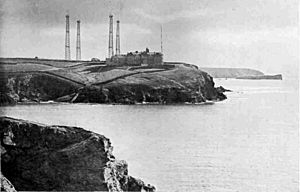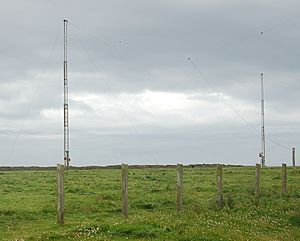Poldhu facts for kids
Quick facts for kids Poldhu
|
|
|---|---|
| Lua error in Module:Location_map at line 530: Unable to find the specified location map definition: "Module:Location map/data/Cornwall (mainland)" does not exist. | |
| OS grid reference | SW663197 |
| Civil parish |
|
| Unitary authority | |
| Ceremonial county | |
| Region | |
| Country | England |
| Sovereign state | United Kingdom |
| Post town | HELSTON |
| Postcode district | TR12 |
| Dialling code | 01326 |
| Police | Devon and Cornwall |
| Fire | Cornwall |
| Ambulance | South Western |
| EU Parliament | South West England |
| UK Parliament |
|
Poldhu is a small, pretty area in south Cornwall, England, UK. It's located on the Lizard Peninsula. The name Poldhu means "black pool" in the Cornish language.
This area includes Poldhu Point and Poldhu Cove. It sits on the coast of Mount's Bay. The village of Mullion is about 2 kilometres (1.2 mi) to the south-east. To the north of Poldhu Cove is the parish of Gunwalloe. The village of Porthleven is 7 kilometres (4.3 mi) further north.
Poldhu Point became famous for a huge step forward in technology. On December 12, 1901, the very first wireless signal was sent from here. Thomas Barron sent the signal from Poldhu. It was received by Marconi in St John’s, Newfoundland. This amazing invention paved the way for radio, television, satellites, and even the internet. You can see a modern example nearby at the Goonhilly earth station.
In January 2016, Poldhu Cove had a strange event. Thousands of pink plastic bottles washed up on the beach. The National Trust thought a shipping container might have fallen into the sea. This likely happened during stormy weather.
Contents
Marconi's Amazing Wireless Station at Poldhu
Poldhu is best known as the place where Guglielmo Marconi built his wireless station. This was the transmitter for the first ever transatlantic radio message. This historic message was sent on December 12, 1901. Marconi received the signal on Signal Hill in St. John's, Newfoundland.
Building the Station
The station was built on land that included old farm fields. Some parts were even on medieval fields. The fifty-acre plot was bought in 1900. Construction started in October 1900 and finished by January 1901. During the building work, two ancient Bronze Age burial mounds were flattened. Workers found a bronze dagger and an urn from those mounds.
How the Transmitter Worked
Marconi hired Professor John Ambrose Fleming to design the spark transmitter. This was the world's first high-power radio transmitter. The first antenna system had twenty masts arranged in a circle. Sadly, a big storm on September 17, 1901, destroyed it.
Marconi quickly built a temporary antenna. It had 50 wires shaped like a fan. These wires hung from a cable between two 200-foot (61 m) masts. Professor Fleming believed the transmitter sent out about 10–12 kilowatts of power. The exact frequency used isn't known, but it was likely around 500 kHz.
Later Experiments and Closure
After the first transatlantic message, Marconi used the site for more experiments. He focused on shortwave transmissions. In 1923, Charles Samuel Franklin sent signals from Poldhu to Marconi in the Cape Verde Islands. In 1924, signals were sent to Beirut.
These experiments had amazing results. They led to Marconi's development of the Beam Wireless Service. This service allowed radio communication across long distances. It connected the British General Post Office to Canada in 1926. Then it connected to Australia, South Africa, India, Argentina, Brazil, and the United States by 1927.
The Poldhu station closed in 1934. It was taken down in 1937. Six acres of the land were given to the National Trust in 1937. The rest of the site was added in 1960.
Poldhu Today
Today, a stone monument pillar stands at the site. It was put there in November 1937 by the Marconi Company. You can also still see some concrete foundations and earth structures. In 2001, a new museum called the Marconi Centre opened. It was built thanks to the Poldhu Amateur Radio Club, the National Trust, and Marconi plc.
Near the site, there's a large building that used to be the Poldhu Hotel. It was built in 1899. Today, it's a care home. Records show that Marconi himself stayed there in 1901. Marconi also built an earlier, smaller experimental wireless station nearby at Housel Bay, known as The Lizard Wireless Station.



